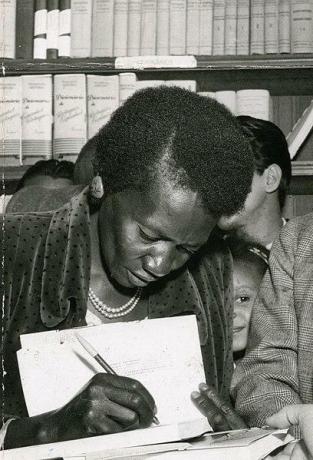Eviction room: diary of a slum dweller is a book of author from Minas Gerais Carolina Maria de Jesus. In this diary, a poor black woman, with two years of formal education, reports events that occurred in the favela of Canindé, in São Paulo, between 1955 and 1959. The writer reflects on the events and shows the social reality of Brazil in the mid-twentieth century.
Read too: Black literature — literary production whose subject of writing is the black person himself
Topics of this article
- 1 - Summary of the work Quarto de despejo
- 2 - Video lesson: Literary analysis of the work Quarto de despejo, by Carolina Maria de Jesus
-
3 - Analysis of the work Eviction room
- → Characters from the work Quarto de eviction
- → Construction time Eviction room
- → Construction space Eviction room
- → Some facts narrated in the work Quarto de despejo
- → Narrator of the work Quarto de eviction
- 4 - Characteristics of the work Eviction room
- 5 - Historical context of the work Quarto de despejo
- 6 - Life of Carolina Maria de Jesus
Summary about the work eviction room
The writer Carolina Maria de Jesus was born in 1914 and died in 1977.
eviction room narrates events that occurred between 1955 and 1959.
The book is a diary and, therefore, presents an autobiographical nature.
The diary shows the social reality of Canindé favela residents.
Video lesson: Literary analysis of the work eviction room, by Carolina Maria de Jesus
Analysis of the work eviction room
→ Characters of the work eviction room
Alfredo: in charge of light
Antonio Lira: fishmonger
Arnold: grocer
Caroline Mary of Jesus: diary author
John Joseph: Carolina's son
Jose Carlos: Carolina's son
Luiz: frei
Manuel: Carolina's suitor
Orlando: water handler
Raimundo: the gypsy
Your Edward: grocer
Vera Eunice: Carolina's daughter
-
Neighbors:
Adalberto
alexander
alice
Amelia
analia
black angelina
Anselmo
Antonio Andrade
Antonio Nascimento
aparecida
Binidite
Binidito
Cecilia
Deolinda
Dirce
cute
Sundays
Durvalino
Elvira
Fernanda
flower
Florentine
Francisca
Francis
Geralda
German
Helium
one way
Iracema
Ireno Venancio da Silva
Isaltine
Ismael
Ivone
John
Joachim
Joseph
Juana
Julian
Leila
Lino
Maria dos Anjos
Maria Jose or Zefa
mariana
Maria Puerta
marli
meiry
Nair Mathias
Nalia
neide
girl
nilton
odete
olga
pitite
polycarp
Ramiro
pink
Rosalina
Sebastiana
Silvia
Teresinha
Thomas
Valdemar
Vilma
Vitor
Zé Maria
Do not stop now... There's more after the publicity ;)
→ Work time eviction room
The events narrated in the diary take place in the years from 1955 to 1959.
→ work space eviction room
The action takes place in the city of São Paulo, specifically in Canindé favela.
→ Some facts narrated in the work eviction room
The diary begins with a mention of the birthday of the author's daughter: Vera Eunice.. Carolina wanted to buy her a pair of shoes, but she didn't have any money. So she found one in the trash: “I washed it and mended it for her to wear”. To get money, the author needs to go out to collect paper.
For this reason, she leaves the children at home, with the recommendation to “play in the backyard and not go out on the street, because the bad neighbors I have don't give socego to my children”. Some neighbors seem to dislike Carolina and her children.. The author also comments that her neighbor Sílvia is constantly beaten by her husband.
Given this, the writer wants to move out of the favela, so that her children don't have to witness things like that. Throughout the work, she mentions political issues. For example, she talks about the preference of one of her neighbors for Jânio Quadros, while Carolina prefers Ademar de Barros.
The author makes it clear to the neighbors that she intends to “write a book about The slum". Sílvia then asks her to remove her name from the book and calls her a “slut”. Furthermore, the author's day-to-day is limited to fetching water, collecting paper or looking for other ways to earn money, washing clothes in the river, making food for the children, when she has something to cook.
On May 2, 1958, Carolina receives “a subpoena to appear to the 8 o'clock at night at Delegacia do 12”, because of her son José Carlos, who is only nine years old. As she forgets to go to the police station, she receives a new subpoena. She appears on the 10th of May. However, the lieutenant is kind and “he took an interest in my children's education”. She does not make clear the reason for the subpoena.
The recurring theme in the diary is hunger. The writer says: “Brazil needs to be led by a person who has already gone hungry. The hunger also and teacher". However, not all neighbors tease the author's family, some are kind and help when they can.
The writer talks about Julião, a teenager who was arrested several times and who sometimes beats his father. She thinks that the favela environment ends up corrupting children, which are “diamonds that turn into lead”, “objects that were in the living room and went to the storage room”.
A man named Manoel expresses his desire to marry her, but she does not want him, as she is in her “maturity”. In addition, according to the author, “a man will not like a woman who cannot pass without reading”. Moreover, several fights in the favela are narrated, mainly between couples.
She says that she “wrote plays and presented them to circus directors”. And they would answer: “It's a shame you're black”. At this point, the writer expresses her pride, writing: “Forgetting them that I love my black skin, and my hair rustic”. While showing her daily life, the author criticizes certain attitudes of her neighbors.
She reflects on the reality of the favela and the country, and, in the face of the evil that certain people in the favela commit against their neighbors, the author asks herself: “Why Does the poor not feel sorry for the other poor?”. Sometimes politicians and also religious go to the favela: politicians, to collect votes; the religious, to get more faithful or to do charity.
The writer always has a critical mind and says that she keeps “[...] thinking about the words of Friar Luiz who tells us to be humble. I think: if Friar Luiz were married and had children and you winwageMinimum, there I wanted to see if Frei Luiz was humble”. And more: “If Frei saw his children eating genres deteriorated, eaten by crows and rats, he would revolt, because revolt arises from hardship”.
With the arrival of “northerners” to the favela, the fights increased, the “northerners” always took a fishmonger at the time of the fight. The reality of the Canindé favela is one of misery, hunger, lack of basic resources and a lot of violence.. But by naming the favela residents and registering their names in the diary, Carolina Maria de Jesus removes them from social invisibility.
In addition to paper, Carolina collects cans and iron ands vendwas going to get some money and survive, feed the kids. On one occasion, a priest goes to the favela to “say Mass” and “told the favelados that they needed to have children”. The priest allegedly told the women there that “when you need bread, you can go get it at the church”.
The author declares in her diary: “To Mr. vicar, the children of the poor raised only on bread. They don't wear and don't wear shoes”. Later, she meets a man whom she calls “gypsy” (Raimundo) and starts to have feelings for him: “The gypsy is disturbing me. [...] I have the impression that I am a shoe and that I have only now found the other foot”. However, she soon discovers that he is not a good man and walks away.
On April 29, 1959, she says she is not willing: “What saddens me is the suicide of Mr Thomas. According to her, he killed himself “because he was tired of suffering at the cost of living”; yet she continues to live. And, after the disappointment with the gypsy, she realizes that she likes Senhor Manoel, “because our friendship is like a root that holds a plant in the ground”.
Thus, on June 4, 1959, she declares: “I slept with him. And the night was delicious.” At that point, the author had already given an interview to the reporter of the cruise, and the report comes out on the 10th. The publication of his book was already arranged.. Carolina Maria de Jesus' life begins to change, now for the better. It starts to become known, it also comes out on the Night Diary.
The author writes in her diary: “I am so happy! It seems that my life was dirty and now they are washing it away”, but he still has no money, he continues to experience difficulties. So, on December 31 of that year, she wishes "that 1960 will be better than 1959". He closes the diary, on January 1, 1960, with these words: “I raised to the 5 hours and I went to charge water”.
→ narrator of the work eviction room
The book is narrated by Caroline Mary of Jesus, author of the diary and, therefore, the main character of the work.
Characteristics of the work eviction room
eviction room It has the structure of a diary. So, the narrative begins on July 15, 1955 and ends on January 1, 1960. The work does not have characteristics of a specific period style, despite having been produced during Brazilian modernism or postmodernism.
The book has an autobiographical character and gives prominence to a female voice, that is, the writer. Through a critical look, she denounces the social reality of her time. The language is colloquial and poetic, with touches of irony. Thus, the author shows elements of her tragic daily life through courageous and moving witness.
See too: anne frank diary — written in the context of World War II
Historical context of the work eviction room
Carolina Maria de Jesus' diary reports events that occurred during the government of Juscelino Kubitschek (1902-1976)mainly. He assumed the presidency on January 31, 1956 and ended his term on January 31, 1961. It was a developmentalist government, whose motto was: “Fifty years in five”.
Despite this, the misery of the “favelados”, shown in the author's diary, indicates that the government's target plan failed to eliminate poverty and hunger in the country. JK promoted a great industrialization of the Southeast, which became a destination for the Northeastern migration. In addition, he was responsible for the construction of Brasilia.
Life of Carolina Maria de Jesus
Caroline Mary of Jesus born March 14, 1914, in the mining town of Sacramento. She was literate in that city, but attended school for only two years in her entire life. As an adult, in 1937, the writer moved to the city of São Paulo. ANDn 1948, she moved to the Canindé favela.

A single mother of three, she needed to pick up paper to survive. Despite the difficulties and hunger, she maintained the habit of reading, in addition to writing in her diary.. When, in 1958, she met the journalist Audálio Dantas (1929-2018), she had fragments of her diary published in the newspaper Leaf of the Night.
Two years later, in 1960, the publication of his famous book. With eviction room, the author met with success and was finally able to leave the favela. Died February 13, 1977, in Parelheiros. Currently, the works of Carolina Maria de Jesus are the object of academic study.
→ Video lesson on Carolina Maria de Jesus
image credits
[1] Collective Reader / Ática Publisher (reproduction)
[2] National Archives / Wikimedia Commons (reproduction)
By Warley Souza
Literature Teacher
Click here to read the analysis of the book Minha vida de Menina, by Helena Morley, and learn about the main characteristics of this work.
Find out who Carolina Maria de Jesus was. Get to know his main works and see why his book Quarto de despejo was so successful.
Understand the importance of Conceição Evaristo's literary and theoretical work. Read his biography, the list of his main works and sample poems.
How many black writers do you know? Understand the concept of black literature and read poems and excerpts from great Brazilian black authors in different periods.
Find out who Maria Firmina dos Reis was. Understand the historical context in which she lived. Know the literary characteristics of her work.
Find out who the Brazilian writer Ruth Guimarães was and learn about the main characteristics of her works. Also read the literary analysis of the book “Água funda”.


